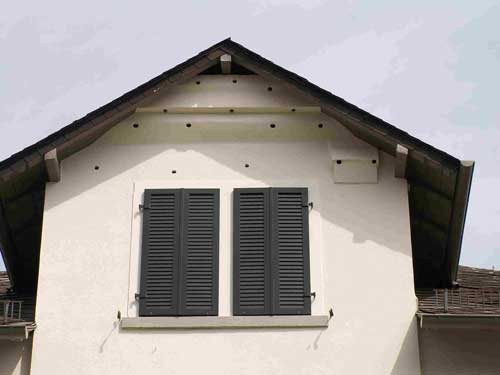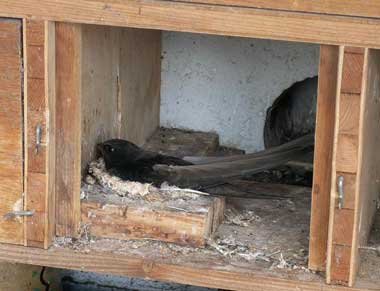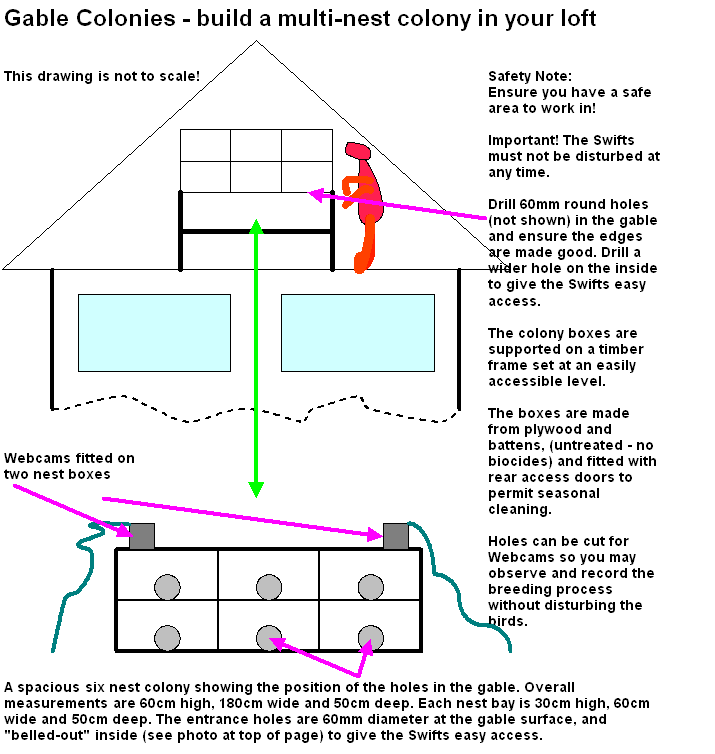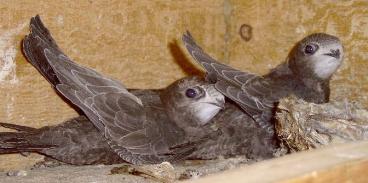Important new knowledge about Swifts is being learnt from these colonies
- you too can build one!
|

|

|
|
Erich
Kaiser's gable colony in Kronberg, near
Frankfurt. About 90 Swifts nest every
year in this house, all in man-made
nest places, like the one on the right. As
local roofs are replaced the area's
birds are increasingly reliant on this
one house to breed in.
|
A
Swift broods its eggs in a gable nest box. Note the entrance hole cut
with a diamond drill; only the outermost part is of narrow diameter to
keep out Starlings and Sparrows.
Photographs © Erich
Kaiser
|
 Swift
enthusiasts like Jan Holmgren in Sweden, Erich Kaiser and August Atzert
in Germany, and Graham Roberts in Portsmouth, have established large
Swift colonies in the gables of their homes. If you have a
non-load-bearing gable (if load-bearing, you need a surveyor's advice
before you start) you should be able to make access holes and install
the wooden boxes and their supports. Take good care to keep your house
weatherproof. Swift
enthusiasts like Jan Holmgren in Sweden, Erich Kaiser and August Atzert
in Germany, and Graham Roberts in Portsmouth, have established large
Swift colonies in the gables of their homes. If you have a
non-load-bearing gable (if load-bearing, you need a surveyor's advice
before you start) you should be able to make access holes and install
the wooden boxes and their supports. Take good care to keep your house
weatherproof.
 A typical scheme is illustrated below. The Swifts
need privacy, adequate space, good ventilation and peace and quiet. Old wooden fruit
boxes can be converted into nest boxes, rather than using new plywood. A typical scheme is illustrated below. The Swifts
need privacy, adequate space, good ventilation and peace and quiet. Old wooden fruit
boxes can be converted into nest boxes, rather than using new plywood.
 Colonies provide excellent opportunities for observation, and
contribute greatly to our knowledge of Swifts. Your
colony can provide new knowledge, hours of satisfaction, and of course, homes for lots more Swifts! Colonies provide excellent opportunities for observation, and
contribute greatly to our knowledge of Swifts. Your
colony can provide new knowledge, hours of satisfaction, and of course, homes for lots more Swifts!

|

|

Left
- A Swift leaves its nest at speed to
collect more food for its chicks. Swifts
are discreet at the nest, moving fast,
they minimise their exposure to predators
like falcons and crows. Above - two
Swift chicks in their nest box. They
will be off to Africa within two weeks.
|
|
|
Photographs © Erich
Kaiser & Ulrich Tigges |
 For further information contact
Swift Conservation For further information contact
Swift Conservation
 Back to Fitting
Swift Nest Places Back to Fitting
Swift Nest Places  Back to Contents
Back to Contents
|
 Gable Colonies
Gable Colonies